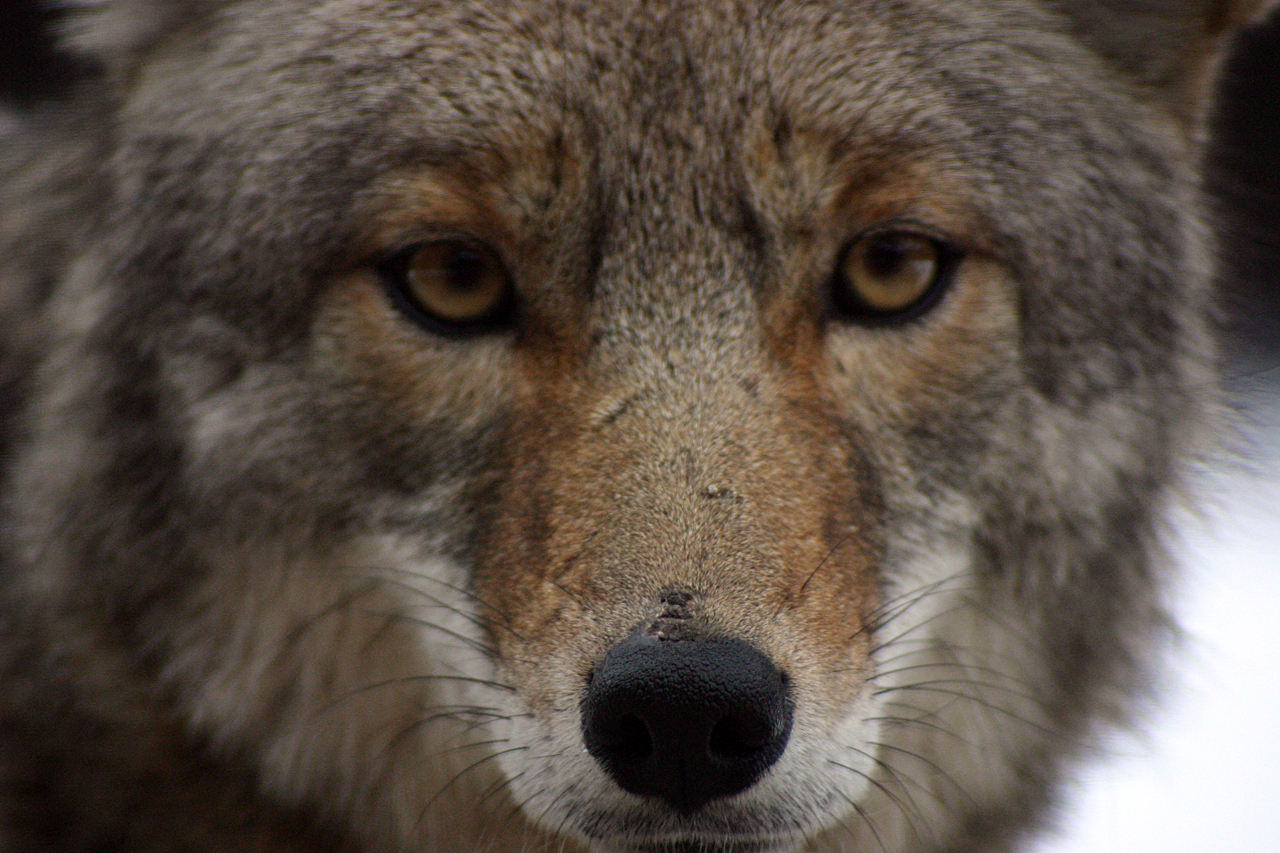A pack of coyotes are getting a little too close for comfort for a Mitchell’s Bay-area family.
Louise Stallaert told the Sydenham Current she has spotted a pack of five or six coyotes less than 100 feet from the back door of her family’s Bay Line home.
“I am at a loss as to how to get these wild animals away from our home,” she said.
Stallaert said about six years ago, they had about nine coyote dens along their back field tree line, but local hunters told them they had move a concession over towards Chatham.
However, this past spring she started noticing more signs of the wild animals.
“In the springtime, at dawn, while taking my dogs on a walk on Angler Line I saw one of the parents heading down the edge of a cornfield towards Bay Line,” she said. “I expect she was bringing food back to her pups, and that is where they decided to live.”
“Soon after that, we were awakened to see our dog returning the barking from a coyote who was just over the bridge at the other side. If we didn’t have dogs I am sure it would have wandered on our property… because they don’t seem to have much fear.”
Stallaert said local residents spotted five coyote pups in the middle of Angler Line.
“I now expect that this pack has grown into full size and these are the ones howling, yipping, barking at my dogs,” she said. “It is especially haunting during summer nights when the windows are open.”
Just at the beginning of the month, Stallaert said her dog chased a pair of coyotes off of their property.
“They were longer than my two dogs in size, but not as robust in weight,” she said. “I think this is the same pack that has grown up in the area since the spring.”
Stallaert added: “Before my run-in with two on the weekend, my husband went outside because of our howling dogs to check things out, it was dark, he couldn’t see how many, but he said it sounded like five or six of them. This was just 100 feet from our back step, over a walking bridge to the back field.”
Stallaert said she wants this large pack to go somewhere else
“I don’t really like the idea of killing animals, but I feel the coyotes are too close to residential areas anymore,” she said. “I would hope they wouldn’t track down a lone walker or lone dog and go after them. That would be frightening. I know that I always make sure our remaining cat comes in for the night. I’d like to discover some natural way of making them move on.”
Ministry of Natural Resources officials say coyotes, like other wild animals, sometimes come into conflict with humans.
“Since migrating to Ontario from the west over 100 years ago, coyotes have adapted well to urban environments and can now be found in both rural and urban settings,” MNR officials stated.
“Coyotes can be found in all of Ontario but are most abundant in southern agricultural Ontario. Coyotes do not survive well north of this area where habitat is different and where they must compete with wolves. Changes in land use, agricultural practices, weather and natural food shortages may contribute to increased coyote sightings in your community.”
The MNR has also provided these tips:
Do not approach or feed coyotes
– Coyotes are usually wary of humans and avoid people whenever possible. However, they are wild animals and should not be approached.
– People should NOT feed coyotes. Feeding them makes the animals less fearful of humans and habituates them to food provided by humans.
– Aggressive behaviour towards people is unusual for coyotes, but people should always exercise caution around wildlife.
If you encounter a coyote
– Never attempt to “tame” a coyote.
– Do not turn your back on or run from a coyote. Back away from the coyote while remaining calm.
– Use whistles and personal alarm devices to frighten an approaching or threatening animal.
Secure garbage and minimize attractants on your property
– Properly store and maintain garbage containers to help prevent coyotes from becoming a problem.
– Place trash bins inside an enclosed structure to discourage the presence of small rodents, which are an important food source for coyotes.
– Put garbage at curbside the morning of the scheduled pickup, rather than the night before.
– Use enclosed composting bins rather than exposed piles. Coyotes are attracted to dog and cat waste as well as products containing meat, milk and eggs.
– Pick ripe fruit from fruit trees and remove fallen fruit from the ground and keep bird feeders from overflowing as coyotes are fond of fruit, nuts, and seeds.
– Protect vegetable gardens with heavy-duty garden fences or place vegetable plants in a greenhouse. Check with your local nursery to see what deterrent products are available.
– Consider eliminating artificial water sources such as koi ponds.
– Keep pet food indoors.
Use deterrents and fences to keep coyotes away from your home and gardens
– Use motion-sensitive lighting and/or motion-activated sprinkler systems to make your property less attractive to coyotes and other nocturnal wildlife.
– Fence your property or yard. It is recommended the fence be at least six feet tall with the bottom extending at least six inches below the ground and/or a foot outward. A roller system can be attached to the top of the fence, preventing animals from gaining the foothold they need to pull themselves up and over the top of a fence.
– Electric fencing can also help deter coyotes from properties or gardens in some circumstances
– Clear away bushes and dense weeds near your home where coyotes may find cover and small animals to feed upon.
– Close off crawl spaces under porches, decks, and sheds. Coyotes use such areas for denning and raising young.
Keep Pets Safe
– Cats and small dogs may be seen as prey by coyotes, while larger dogs may be injured in a
confrontation.
To avoid these situations consider the following suggestions:
– Install proper fencing.
– As coyotes are primarily nocturnal, animals should be kept inside at night.
– Keep all pets on leashes or confined to a yard.
– Keep cats indoors and do not allow pets to roam from home.
– Walk your dog on a leash at all times. If your yard does not have a fence, use a leash while on your property to keep your dog close to you.
– Spay or neuter your dogs. Coyotes are attracted to, and can mate with, domestic dogs that have not been spayed or neutered.
Prevent predation on livestock
– Barns or sheds can provide effective protection from coyote predation for livestock that bed inside or nearby at night.
– Guard animals, such as donkeys, llamas and dogs can be a cost-effective way to protect livestock from coyotes. Guard animals will develop a bond with livestock if they are slowly integrated and will aggressively repel predators.
The MNR has also provided information for preventing and managing conflicts with coyotes, wolves and foxes
What to do if you encounter a coyote, wolf or fox
If you see a coyote, wolf or fox, keep your distance and the animal will most likely avoid you.
If you encounter an aggressive animal:
– Never approach or touch a wild animal
– Do not turn your back or run from a wild animal
– Back away from the animal while remaining calm
– Stand tall, wave your hands, and make lots of noise
– Carry a flashlight at night
– If a wild animal poses an immediate threat or danger to public safety — call 911
How to make your property unwelcome
– Use flashing lights, motion sensors and noise makers
– Put up two-metre high fence that extends at least 20 centimetres underground
– Install a roller system to the top of your fence so animals can’t gain a foothold
How to prevent conflicts with dogs
– Keep dogs inside at night
– Clean up after your dog — coyotes are attracted to dog feces
– Spay and neuter your dogs — coyotes are attracted to, and can mate with, domestic dogs that have not been spayed or neutered
How to protect livestock
– Where possible, bring your livestock into barns or sheds at night
– Use guard animals, such as donkeys, llamas and dogs
– If livestock has been killed by predators, you may be eligible for compensation through the Ontario Wildlife Damage Compensation Program
Lethal action
– As a last resort, a farmer may humanely kill or trap wolves, coyotes or foxes that are damaging or about to damage their property
– If you are using a firearm, you must follow certain regulations and local bylaws
– Landowners may also hire an agent to act on your behalf
How to find a trapper
– To locate a licensed trapper, contact: Ontario Fur Managers Federation – 705-254-3338 or email furman@furmanagers.com
The OSPCA has also provided information about coyotes:
– Coyotes: Living With Wildlife
Chatham-Kent officials say residents who would like wildlife removed from their properties, must do so at their own expense.
“Contact a pest control provider or a licensed trapper,” the Chatham-Kent website states. “Refer to the yellow pages for a listing of trappers or contact the Ministry of Natural Resources at 519-773-9241 for an updated list. You may also call the municipality for the MNR’s list of licensed trappers at 519-360-1998. In the event of an immediate danger to humans by wildlife, contact Police Services.”
















